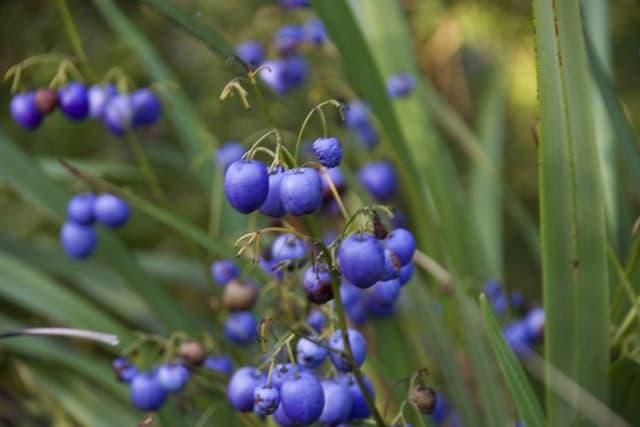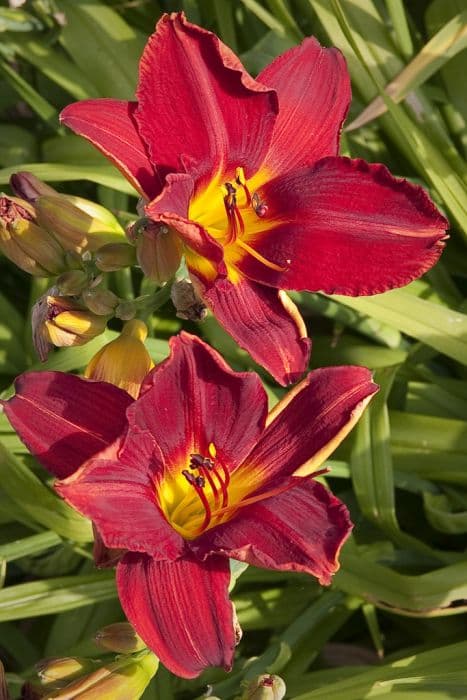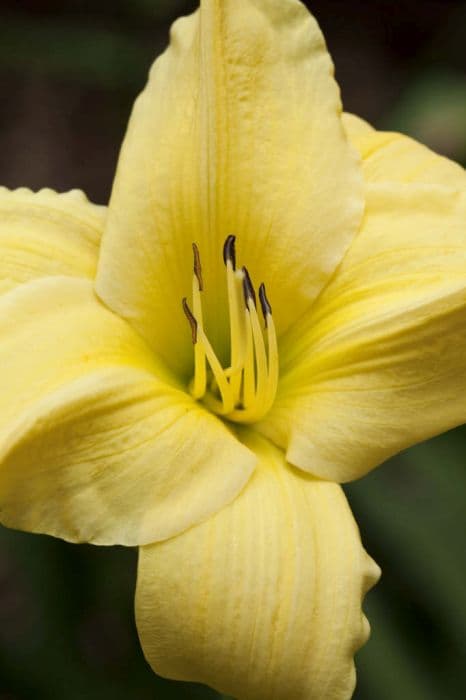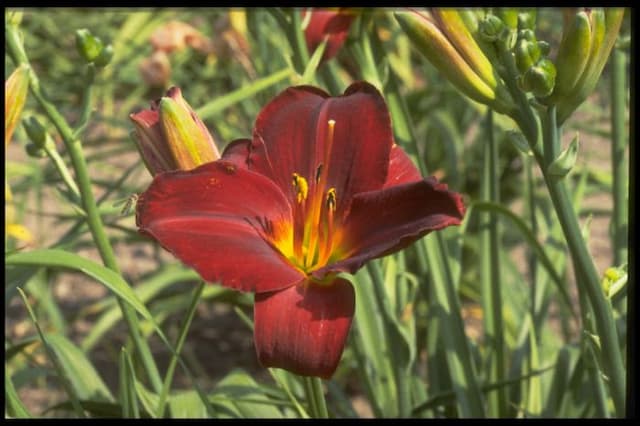Daylily Hemerocallis 'Bonanza'

ABOUT
The Hemerocallis 'Bonanza' is commonly known as the Daylily 'Bonanza'. This plant is renowned for its vibrant and showy flowers. The blooms are typically a deep golden-yellow hue with a contrasting maroon eye at the center, which adds an alluring touch to the overall appearance. These blossoms are trumpet-shaped, a classic feature of daylilies, with slightly ruffled edges that give them a frilly, delicate look. The foliage of the Daylily 'Bonanza' is a lush green, forming clumps of long, slender, arching leaves that serve as a lush backdrop to the colorful flowers. This plant is a perennial, meaning it will return year after year to provide a splash of color in gardens. The Daylily 'Bonanza' flowers emerge on long, sturdy stems that rise above the foliage, creating an eye-catching display when the plant is in full bloom. Each individual flower typically lasts just one day, but the plant produces numerous buds that open in succession over a period of time during its blooming season, ensuring a long-lasting floral show. Because of their striking appearance, these daylilies are often used as borders or for mass plantings in landscape designs. They also make excellent cut flowers for indoor arrangements due to their bold color and appealing form.
About this plant
 Names
NamesFamily
Hemerocallidaceae
Synonyms
Daylily, Common Daylily, Tawny Daylily, Orange Daylily
Common names
Hemerocallis 'Bonanza'.
 Toxicity
ToxicityTo humans
Daylilies (Hemerocallis 'Bonanza') are not considered toxic to humans. In fact, many parts of the daylily are edible and are consumed in certain cuisines, especially in Asia. However, it is important to note that some individuals may have allergies or sensitivities to these plants, which could cause mild stomach upset if ingested. Always exercise caution and ensure correct identification before consuming any plant.
To pets
Daylilies are highly toxic to cats. All parts of the daylily plant can cause serious harm if ingested by cats. Symptoms of daylily poisoning in cats may include vomiting, lethargy, kidney failure, or death. If you suspect your cat has ingested any part of a daylily, seek veterinary assistance immediately. It is crucial to prevent cats from having any access to daylilies.
 Characteristics
CharacteristicsLife cycle
Perennials
Foliage type
Deciduous
Color of leaves
Green
Flower color
Yellow
Height
2 feet (60 cm)
Spread
2 feet (60 cm)
Plant type
Herb
Hardiness zones
Varies
Native area
Asia
Benefits
 General Benefits
General Benefits- Easy to Grow: The daylily is known for its hardiness and ability to thrive in various conditions with minimal care.
- Drought Tolerant: Once established, daylilies can survive periods of drought, making them suitable for water-wise gardens.
- Pest Resistance: Daylilies are generally resistant to many pests and diseases, reducing the need for chemical treatments.
- Versatile Landscaping Plant: They can be used in borders, beds, and as ground cover, adapting well to different landscaping designs.
- Long Blooming Period: Daylilies can bloom for several weeks, with some producing flowers from early summer to fall.
- Range of Colors: Available in a variety of colors and patterns, they can add visual interest to any garden space.
- Low Maintenance: They require minimal pruning and grooming, making them a convenient choice for busy gardeners.
- Propagate Easily: Daylilies can be easily propagated by division, allowing gardeners to spread them throughout their garden or share with others.
- Attracts Pollinators: The vibrant flowers attract butterflies, bees, and other beneficial insects that aid in the pollination of gardens.
- Tolerant of Different Soils: They can grow in a range of soil types, as long as the soil is well-drained.
- Fast Growth: Daylilies establish quickly and can fill in bare spots in the garden rapidly.
 Medical Properties
Medical PropertiesThis plant is not used for medical purposes.
 Air-purifying Qualities
Air-purifying QualitiesThis plant is not specifically known for air purifying qualities.
 Other Uses
Other Uses- The flowers of daylilies like Hemerocallis 'Bonanza' can be pressed and used in floral crafts, such as making bookmarks or decorative cards, by carefully drying them between sheets of paper to preserve their color and shape.
- Daylily petals can be crystallized with egg white and sugar to create an edible and decorative topping for cakes and desserts.
- The sturdy foliage of daylilies can be used as a natural planting border to outline garden paths or divide different areas of a landscape design.
- Dried daylily blooms can be incorporated into potpourri mixtures to add color and a mild fragrance to a room.
- Daylilies, when planted in masses, can be utilized for erosion control on slopes due to their dense root systems that hold soil in place.
- The blooms of daylilies can serve as a natural dye for fabrics, providing hues ranging from yellow to orange, depending on the part of the flower used.
- Daylilies can be used as a living mulch, as their foliage can suppress weed growth and help maintain soil moisture when planted densely.
- The flower buds of daylilies can be pickled for a unique, tangy addition to salads and sandwiches, much like capers.
- When daylily flowers are past their prime, they can be added to compost piles as a green material to help balance carbon-nitrogen ratio for effective composting.
- The stems and spent blooms of daylilies can be repurposed as natural plant stakes or supports for other, more delicate plants in the garden.
Interesting Facts
 Feng Shui
Feng ShuiThe plant Daylily is not used in Feng Shui practice.
 Zodiac Sign Compitability
Zodiac Sign CompitabilityThe Daylily is not used in astrology practice.
 Plant Symbolism
Plant Symbolism- Daylily: The most common name for Hemerocallis 'Bonanza' is Daylily. This name is rooted in the Greek words 'hemera' meaning day and 'kallos' meaning beauty, reflecting that each flower typically lasts only for a day.
- Beauty: Reflective of its genus name and transient blooming period, daylilies symbolize the fleeting nature of beauty.
- Motherhood: In Chinese culture, daylilies are associated with motherhood and the nurturing aspect due to their abundance and perennial nature.
- Forgetfulness: The ephemeral blooms also lead to an association with forgetting worries and embracing new joys each day.
- Coquetry: Daylilies can represent flirtatious behavior, likely stemming from the brief appearance of their individual flowers.
 Water
WaterThe Daylily (Hemerocallis 'Bonanza') should be watered deeply and thoroughly, allowing the water to penetrate the soil to a depth of at least 8 to 10 inches. During the active growing season, typically when temperatures are higher, water once a week with about 1 to 1.5 gallons of water per plant, ensuring moisture reaches the root zone. In periods of extreme heat or drought, increase the frequency to twice a week. Reduce watering in the fall as the plant prepares for dormancy, and in winter, water only if the soil is very dry. It's crucial to avoid overwatering to prevent root rot.
 Light
LightThe Daylily thrives best in full sun conditions, requiring at least 6 to 8 hours of direct sunlight daily to bloom optimally. Placing the Daylily in an area with ample morning light and some afternoon shade can help protect the flowers from intense heat in the hottest parts of the day. However, avoid heavy shade, as this can significantly reduce blooming.
 Temperature
TemperatureDaylilies are tolerant of a wide range of temperatures, but they grow best when the daytime temperature is between 60° and 75° Fahrenheit. They can survive minimum temperatures down to about 20° Fahrenheit, although prolonged exposure to temperatures below freezing can damage the plant. Ideally, maintain a frost-free environment to ensure healthy growth and abundant flowering.
 Pruning
PruningPruning Daylilies involves removing spent flower stalks and dead foliage to encourage more blooms and maintain a neat appearance. Trim back the foliage in late fall to prepare for winter, leaving about 2 to 3 inches above the ground. Remove any diseased or damaged parts as needed throughout the growing season. The best time for heavy pruning is either early spring before new growth begins or late fall after the plant has gone dormant.
 Cleaning
CleaningAs needed
 Soil
SoilThe ideal soil mix for daylilies should be well-draining with a mix of loam, sand, and organic matter like compost. They thrive in soil pH range of 6.0 to 6.8. Aerated and fertile soil leads to healthy blooms.
 Repotting
RepottingDaylilies rarely need repotting as they are perennial and typically grown outdoors. They should be divided every 3 to 5 years to maintain vigor and prevent overcrowding.
 Humidity & Misting
Humidity & MistingDaylilies are not particularly humidity-sensitive and can thrive in a wide range of humidity levels found in typical outdoor environments.
 Suitable locations
Suitable locationsIndoor
Use bright, indirect light and well-draining soil mix.
Outdoor
Plant in sun to partial shade, well-draining soil, water deeply.
Hardiness zone
3-9 USDA
 Life cycle
Life cycleThe common name for Hemerocallis 'Bonanza' is Daylily 'Bonanza'. It starts as seeds or can be propagated through division of clumps. The seeds germinate, and shortly after, seedlings emerge with basic leaf structures. As the plant matures, it develops a clump of grass-like leaves and a root system that establishes itself over a few years. The daylily 'Bonanza' reaches a flowering stage each summer, producing large, colorful blooms that typically last just one day before wilting; new flowers continue to open over several weeks. After the flowering season, the plant enters a period of vegetative growth and storage of energy for the next cycle, and as temperatures drop, it goes dormant in winter, with the cycle repeating each year as the plant grows larger and produces more blooms.
 Propogation
PropogationPropogation time
Early spring
The most popular method of propagating the daylily 'Bonanza' is through division, which is best done in either early spring or late summer. This perennial plant produces clumps that can be easily split to create new plants. To propagate, dig up the entire clump of daylilies, gently shaking off the excess soil. Using a sharp knife or spade, divide the clump into smaller sections, each with at least three to four fans of leaves and a portion of the root system. Replant the divisions at the same depth they were previously growing, spacing them about 12 to 18 inches apart (roughly 30 to 45 centimeters), to allow enough room for growth. Water the new divisions well to help establish them in their new locations. This straightforward method not only helps to propagate the daylily but also rejuvenates older clumps, encouraging more vigorous growth and flowering.









